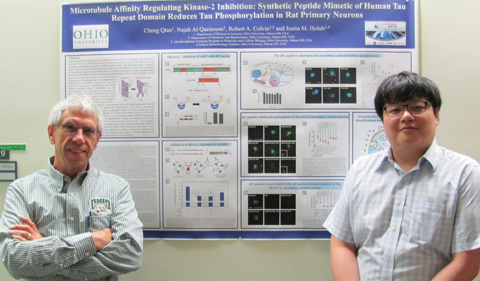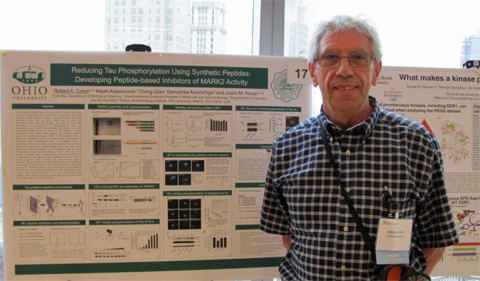
Dr. Robert Colvin and Cheng Qian present at Experimental Biology 2017.
Dr. Robert Colvin and graduate student Cheng Qian attended Experimental Biology 2017, held April 22-26 in Chicago, and presented a poster on “Microtubule Affinity Regulating Kinase-2 inhibition: Synthetic Peptide Mimetics of Human Tau Repeat Domains Reduce Tau Phosphorylation in Rat Primary Neurons.”
Colvin is Professor of Biological Sciences and Director of the Interdisciplinary Program in Molecular and Cellular Biology. Qian is a graduate student in the Biological Science program.
Co-authors included Najah Al Qaeisoom, a graduate student in Chemistry & Biochemistry, and her adviser, Dr. Justin M. Holub, Assistant Professor.
Abstract: The microtubule-associated protein tau stabilizes microtubules by interacting with tubulins in neurons. Tau that is post-translationally phosphorylated can dissociate from tubulin, leaving polymeric microtubule structures in highly dynamic states. Tau phosphorylation at specific amino acids is precisely regulated by tau kinases and tau phosphatases. When this machinery is dysregulated, tau can become hyper-phosphorylated. Prolonged dissociation of hyper-phosphorylated tau induces microtubule collapse and disrupts axonal transport. More critically, phosphorylated tau can form prion-like oligomers, which have been implicated in the pathogenesis of age-dependent neurodegenerative diseases such as Alzheimer’s disease (AD). Elevated activity of tau kinases, including microtubule affinity regulating kinase 2 (MARK2), has been demonstrated during AD pathogenesis. MARK2 is known to phosphorylate tau in one of four repeat (R) domains. Our objective was to develop synthetic peptide mimetics of human tau R domains as non-cytotoxic, cell-permeable ligands to inhibit MARK2-mediated phosphorylation of endogenous tau. A series of human tau R domain mimetics were synthesized and showed minimal effects on viability when added to rat primary cortical neurons at concentrations up to 100 μM. Antibody-based fluorescence polarization assays were used to demonstrate that our hTau R1 peptide mimetic was a ligand of MARK2 in vitro. We observed that fluorescent hTau R1 was internalized by cortical neurons and were present throughout the cell body, neurites and puncta, suggesting internalization by an endocytotic pathway. Treating cortical neurons with phenylarsine oxide (PAO) to upregulate MARK2 activity increased endogenous tau Ser262 phosphorylation 290 ± 23.9% over non-treated controls. Interestingly, co-treatment of PAO-treated cells with hTau R1 and endosome disruptor bafilomycin A1 reduced Ser262 phosphorylation levels to 200 ± 17.1% over non-treated controls. PAO also significantly reduced phosphorylation of tau at Thr231 through an unknown mechanism. Notably, co-treatment of PAO-treated cells with hTau R1 and bafilomycin A1 did not change the level of phosphorylated tau at Thr231. Furthermore, a six-day pre-incubation of cortical neurons with 10 µM hTau R1 significantly reduced the okadaic acid-induced tau phosphorylation at Ser262, but did not have a measurable effect on the level of phosphorylation at Thr231. Taken together, these data suggest that R1 peptides are internalized by cortical neurons and inhibit MARK2-dependent phosphorylation of endogenous tau at Ser262 when delivered to the cytosol. Importantly, these results show that hTau R1 peptide mimetics are capable of selectively inhibiting tau phosphorylation at other kinases-dependent sites. We anticipate that hTau R1 peptide mimetics will serve as strong leads in the development peptide-based AD therapeutics and as tools to study the complex nature of tau biology.



















Comments